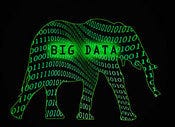Can Big Data Trump Doping In Sports?Can Big Data Trump Doping In Sports?
Massive amounts of data, along with Hadoop and visualization tools, helped the U.S. women's cycling team earn silver at the London 2012 Olympic Games.


5 Big Wishes For Big Data Deployments
5 Big Wishes For Big Data Deployments(click image for larger view and for slideshow)
Disgraced cyclist Lance Armstrong made headlines last week when he told French newspaper Le Monde that he couldn't have won the Tour de France without doping. But velodrome cyclist and entrepreneur Sky Christopherson, speaking Thursday at the Hadoop Summit in San Jose, Calif., offered a more hopeful perspective: Racers can win with big data analysis instead of performance-enhancing drugs.
Christopherson was a member of the U.S. Cycling Team and alternate on the 1996 and 2000 U.S. Olympic teams. In 2011, using a data-intensive "digital health" program designed to help competitive athletes achieve drug-free performance breakthroughs, Christopherson broke a world record in the 200-meter velodrome sprint.
"Doping is a huge issue right now in sports," Christopherson told Hadoop Summit attendees in his June 27 keynote. "And the reason it's been abused by athletes is that it accelerates recovery. At this level of athletics, everyone is training hard enough. The key is: How do you recover faster?"
[ The more data the bigger the blunders? Read Big Data's Human Error Problem. ]
Optimized Athlete, a company that Christopherson co-founded with his wife Tamara in early 2012, helped the U.S. women's cycling team shave several seconds off their racing times, an improvement that earned the team a silver medal at the 2012 Summer Olympics in London.
Data analysis, including machine sensors and mobile devices, played a major role in this effort.
"I think the biggest difference most recently is you have this flood of sensors hitting the market, wireless sensors that connect with a smartphone. And we're able to quantify parts of our physiology and our psychology that we never could before," said Christopherson in a promotional video proceeding his keynote.
"The U.S. Women's Cycling Team was in a tough position because going into the London Olympics in 2012 they were five seconds away from even being considered for the medals. And a lot of people thought that a near-impossible task, you know, to improve this huge margin of time and be competitive in the games," he said. Christopherson's team used intensive data analysis to improve the cyclists' performance.
"We generated all this data, you know, everything from genetics tests to continuous blood glucose tracking, sleep tracking. We even made this sensor on our own that tracked environmental data for each athlete," recalled Christopherson.
But this deluge of big data created a new set of problems. "In the beginning it was like, 'Wow, we have all this great data,' but it became very hard to manage," he noted. "You know, we were sampling at one second, 24 hours a day, 7 days a week from all these different devices. And it got really overwhelming."
The data eventually became impossible to manage with conventional software applications.
"I remember at one point the spreadsheet was taking longer and longer to open, until one day I got, you know, the spinning wheel of death, and it just completely locked up," said Christopherson.
After quickly researching various data management solutions, Christopherson's team chose Datameer, an analytics software provider with drag-and-drop design tools that allow Hadoop users to quickly create infographics and data visualizations without any coding.
Datameer "had nice ways to integrate and analyze the data, good visualization tools, and that's exactly what we needed, you know, to see how all of this data was interrelated and how it was correlated," said Christopherson.
One insight his team uncovered was related to the athletes' circadian rhythms.
"We saw in the data that early morning sun exposure … not just on the skin for Vitamin D synthesis, but actually in the eyes … was kind of anchoring biorhythms, and that was related to sleep latency and quality, which improved recovery," Christopherson recalled.
"When we got to London, where it was cloudy and overcast, we actually used light box therapy in (the athletes') rooms in the Olympic village to ensure they had the same sleep cycles, along with temperature control and some other things," he added.
The cyclists' silver medal performance was far better than expected, a showing that Christopherson attributes, at least in part, to insights gleaned from the collected data.
"I think the exciting thing about this project is that we went into this five seconds down, not even close to the medals, and we came away with a silver medal. And I think that's more than any of us could have asked for," he said.
To understand how to secure big data, you have to understand what it is -- and what it isn't. In the Security Implications Of Big Data Strategies report, we show you how to alter your security strategy to accommodate big data -- and when not to. (Free registration required.)
About the Author
You May Also Like






